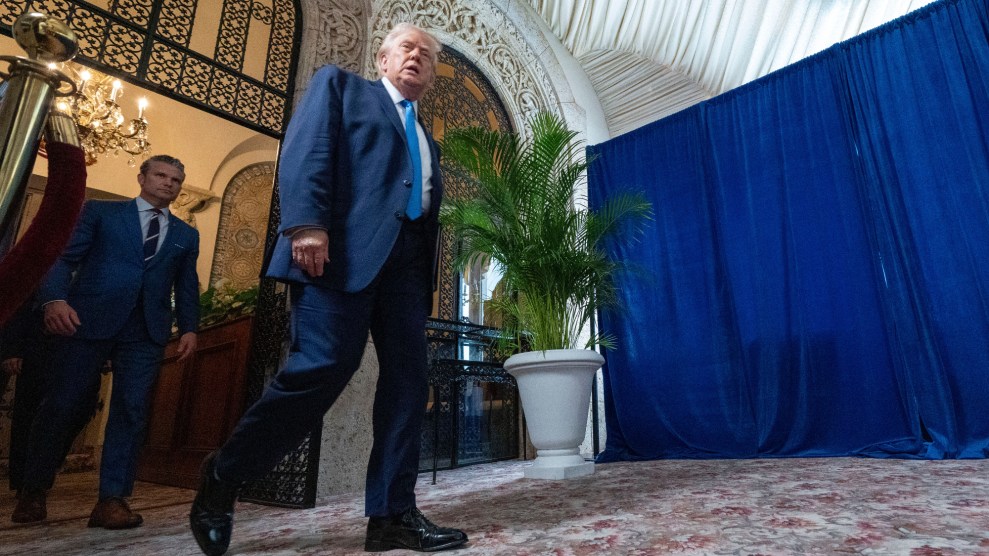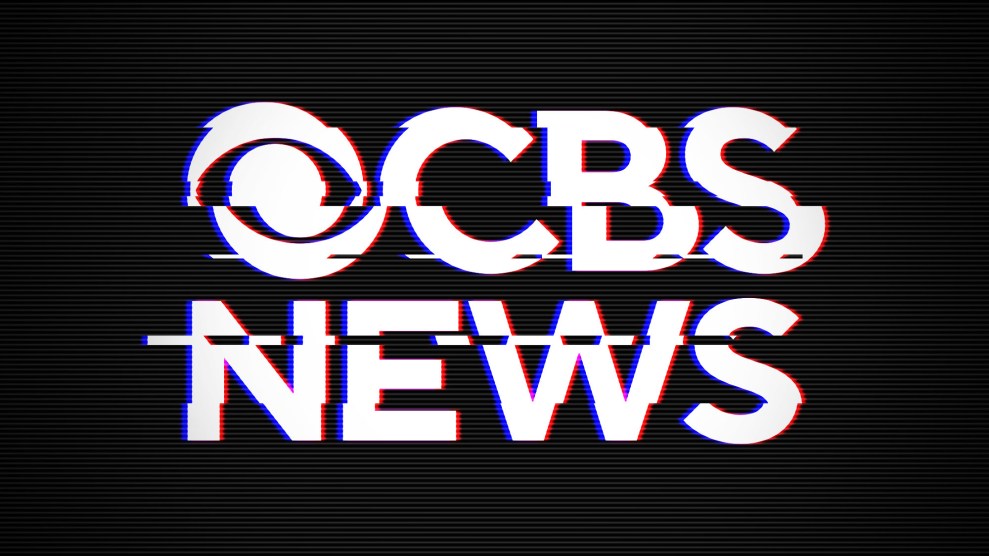Neal Knox’s feisty greeting echoes out over an audience of 150 activists at the National Rifle Association’s 125th anniversary convention in April. Knox, the NRA’s first vice president, is the architect of a revolution that has transformed the group from an organization of hunters and target-shooting sportsmen into a militant faction pushing such issues as concealed weapons, assault rifles, and armor-piercing bullets. Although nominally the group’s number two executive (behind recently elected president Marion Hammer), Knox calls the shots at the NRA, exercising near-absolute control of its board of directors.
Today, the first day of the NRA’s annual convention, Knox is urging the assembled activists to carry out their assigned tasks in the 1996 elections: toppling President Clinton and protecting “at all costs” the pro-gun party in Congress. He tells them not to worry about the anger they provoke in liberals and gun control advocates. “All that hostility,” Knox chuckles, “means you’re getting through to them.”
Knox’s appeal to the hardliners differs markedly from the kinder, gentler image the NRA is trying to broadcast to the general public. As the NRA gears up for its take-no-prisoners election drive, the theme it is repeating again and again in interviews, speeches, and literature is “family values.” Even one of the convention press kits is titled, “Meet the NRA Family.”
The standard bearer for the family values campaign is NRA matriarch Marion Hammer, the hardline president elected last December with Knox’s support. Hammer, a 57-year-old grandmother, has been a public relations bonanza for the NRA, drawing the attention of newspapers and network TV reporters. (“The media,” wrote Hammer in the NRA monthly American Rifleman, “has become fixated on the idea of a woman serving as NRA president.”)
Hammer tells the convention crowd she intends to make families and youth the centerpiece of her presidency. Introducing her 10-year-old grandson, she notes proudly that the boy knows “how shooting teaches you good lessons of life.”
After Hammer finishes speaking, the NRA’s other pistol-packing grandmother, 58-year-old Tanya Metaksa, takes the podium. Executive director of the Institute for Legislative Action, the NRA’s political and lobbying arm, Metaksa picks up on the family theme, attacking Hillary Clinton’s It Takes a Village. “In this book the author tells us [that] to raise a child it takes a village,” Metaksa says. “It doesn’t take a village. It takes a family…. [And] I have just the family for you: an American family committed to safety, responsibility, freedom. This American family. The NRA.”
However appealing the image of a united, caring NRA family, it masks a harsher reality. Interviews with former NRA leaders — including the past two chairmen of the organization’s finance committee and other recent board members — reveal the NRA family is highly dysfunctional. Knox, the group’s authoritarian patriarch, is pulling the organization ever further away from the majority of its membership and toward the political fringe. And he is ruthlessly kicking anyone who disagrees with him out of the “family.” Those who remain are kept in line by their fear of Knox or by their cultlike devotion to the charismatic leader. Meanwhile, the NRA is ignoring its financial commitments to its broad membership, gambling its future on Knox’s political campaigns, and attacking conservatives, such as Rep. Linda Smith (R-Wash.), who speak out against political corruption.
The 1977 NRA convention in Cincinnati marked the organization’s shift from the hands of traditional sportsmen to those of militant political hardliners. Neal Knox, then an NRA member and editor and columnist for two gun magazines, led the effort to rid the NRA of its old guard, which wanted to move headquarters from Washington, D.C., to Colorado. Knox initiated a lengthy floor debate on bylaw changes, according to Paul Daniels, a former member of the board of directors who attended the convention. When the debate dragged into the early morning, most of the moderates left, leaving only those who were intent on changing the organization. Those present voted to allow the full membership to elect the executive vice president. Soon after, Harlon Carter was elected to the position, and within a year, Carter appointed Knox the executive director of the NRA’s Institute for Legislative Action.
Although ousted in 1982 for lobbying efforts that conflicted with NRA policies, Knox founded a coalition of like-minded gun aficionados. Using his influence as a widely read columnist and publisher, allied with Soldier of Fortune magazine’s Robert K. Brown, he once again took control of the NRA in 1991.
Knox, 61, relishes his image as a pro-gun extremist. In his newsletter column in “Shotgun News,” he has defended militias and argued that an anti-gun conspiracy staged the assassinations of the Kennedys and Martin Luther King.
“I liken Neal Knox to a TV evangelist who has convinced his followers that his form of ruling is the way to heaven,” says Paul Daniels. Clarence Lovell, a board member from 1980 to 1993, concurs: “It’s a personality cult.”
Knox has retained an iron grip on the NRA by pushing dissenters like Daniels and Lovell off the board and replacing them with directors who follow his orders. (See memo | Text-only version) At a recent board meeting, a vote stalled when Knox was preoccupied in a discussion. One board member asked him, “Would you please tell these people how to vote?” As Knox raised his hand to vote, dozens of other hands went up in unison. “He is a very, very good machine politician,” says Max Goodwin, a former Coors executive who chaired the NRA’s finance committee until 1994.
Each year, Knox uses allies on the NRA nominating committee to handpick a slate of candidates for the board. Before candidates get the nod from the nominating committee, they are vetted by Knox. “They are prequalified,” says Dave Edmondson, another former board member and Knox foe. “They get a phone call, and they are asked to promise to follow Knox.” Adds Lovell, “They have to swear a loyalty oath to Knox. It’s dirty politics…. The board members are so scared that they don’t even talk to each other.”
Knox is able to maintain control of the board because only a tiny percentage of the NRA’s 3 million members vote in board elections. One reason is that the NRA leadership allows only life and five-year members to vote for the 75-member board, thus ensuring that only the most committed, hard-core activists have a say in the direction of the organization. (In 1994, the NRA created a special 76th director, elected at the annual convention, for whom all members are allowed to vote.)
In the 1996 board elections, for example, only 71,615 life and five-year members — or 2.4 percent of the total NRA membership — voted for 25 open seats on the board. With such a small turnout, Knox’s partisans can easily carry the day: Indeed, all 25 of the board members elected this year received the approval of Knox’s nominating committee. After the election, which ousted several of the board’s last independent directors, a colleague asked Knox what he thought of the vote. “I only count four of them left,” says Knox, referring to the NRA’s moderate traditionalists.
Recently, Knox and the board have taken further measures to centralize control, including passing a confidentiality clause for employee contracts, says Wayne Anthony Ross, a former NRA first vice president and one of the few current board members to have been re-elected without a recommendation from the nominating committee. Employees must agree not to talk about the inner workings of the NRA to outsiders; Ross says he fears they will also be told not to reveal information to board members.
“Once upon a time in the NRA,” says Daniels, “you could speak your mind. Now, you better not open your mouth unless you whisper in Knox’s ear what you intend to do.”
It’s been widely reported that the NRA’s April convention drew 29,000 people. But largely left unsaid is the fact that virtually all of them were curious gun collectors, target shooters, and hunters with little interest in politics. Only a handful of hard-core activists attended the widely advertised political sessions. At a special session of the Institute for Legislative Action, for example, only 300 people showed up at an arena designed to hold 10,000.
This low turnout might worry the NRA except for one thing: In recent years, the group’s political fortunes have depended not on its membership but on its money. Disguised as a powerful grassroots organization, the NRA is first and foremost a money machine. Despite the group’s large membership, few members are political activists.
In reality, NRA members, targeted by expert fundraising efforts, are the cash cow supporting the political goals of the group’s hardline leadership. Last year, the NRA managed to raise more than $120 million in member dues and contributions.
The NRA’s political action committee, the Political Victory Fund, is the nation’s largest; in 1994, this PAC outspent all other groups with $5.3 million in direct campaign contributions, “independent expenditures” on behalf of pro-gun candidates, and money for phone banks and mailings to NRA members telling them how to vote. The bulk of that money contributed mightily to the Republican Party’s takeover of Congress — 79 percent of NRA campaign contributions and 87 percent of the independent expenditures went to the GOP. For this year’s election, the NRA has tilted even further toward the Republicans.
Under Federal Election Commission rules, no individual is allowed to contribute more than $5,000 to a PAC for use in political campaigns. To get around this rule, the NRA essentially “launders” its large donations. Wealthy NRA patrons make major contributions — say, $10,000, $100,000, or more — which the NRA then spends on expensive direct mail solicitations that result in large numbers of smaller contributions to its PAC.
In addition, the NRA Foundation, a supposedly charitable organization created by the NRA six years ago, raises millions of dollars more for “educational” purposes. But an analysis by Mother Jones of the foundation’s 1994 annual report shows that of the $2.8 million in grants given out by the tax-free charity, at least $2.3 million was granted back to the NRA itself, to finance programs such as “Collegiate Shooting,” “Shooting Range Development,” and “Eddie Eagle Elementary Gun Safety.” Such expenditures free up other NRA money for political purposes, from PAC fundraising to soft money political gifts. The political clout the NRA’s money buys was already on display earlier this year when the House of Representatives voted in March to repeal the 1994 ban on certain kinds of semiautomatic assault weapons. The March vote, which took place despite objections from moderate Republicans, was widely viewed as an NRA power play and a warning that the NRA plans to use its muscle in the 1996 elections.
The NRA’s political power has not come without a price. Knox’s expensive political campaigns have thrown the organization’s finances into disarray. According to figures released at the Dallas convention, the NRA now faces a deficit of more than $43 million in net assets, a sharp drop from the huge surpluses it registered just a few years ago. To make matters worse, last year the NRA received Dun & Bradstreet’s lowest credit rating, according to the Associated Press. The organization is also the target of an ongoing probe by the Internal Revenue Service.
Those likely to be hit hardest by the NRA’s deficit spending are its rank-and-file members. Former finance chair Max Goodwin points out that the NRA has spent virtually all of the money it should have saved to pay for magazines and other benefits promised to current and future members, especially those with lifetime and long-term memberships. “In 1989, the NRA had an actuary study this,” says Goodwin. “He estimated the NRA needed between $125 million and $140 million to cover these future liabilities.”
According to Goodwin, the organization’s cash reserves have dropped from $125 million in 1990 to about $40 million, with nearly all of that pledged as collateral on a shiny new headquarters in Fairfax, Virginia. The NRA, he says, has squandered most of the money on costly membership recruitments and political causes. The Knox-controlled board of directors repeatedly overruled more conservative recommendations from its own finance committee. “We were outvoted,” says Goodwin. “So many times over the years, we said, ÔDon’t deficit-spend. Tell us where the money is coming from.'”
“They’re spending all their money on today’s battles,” adds board member Wayne Anthony Ross, “and not saving for the next generation of hunters.”
James W. Porter, an Alabama attorney who succeeded Goodwin as finance chair and served until earlier this year, says he voted against every single budget proposed during his tenure on the board. Porter adds that the leadership was slow to get financial records to the finance committee. “The only information we would get would come shortly before the meeting,” he says. Porter lost his seat on the board when the Knox-controlled nominating committee refused to endorse his re-election.
Further, the NRA’s membership has fallen in the past year, from a high of 3.5 million (inflated by expensive direct mail recruitment campaigns) in early 1995 to less than 3 million now. “Between February and December 1995, they lost more than 625,000 members,” says Dave Edmondson. That drop, along with the financial difficulties caused by years of deficit spending, means the NRA will have to stretch its resources to the limit to wage its promised all-out effort to defeat Clinton.
Knox is gambling the NRA’s future on a big win this year. Given the precarious nature of the NRA’s finances, it may be an all-or-nothing bet. A win would make Knox a powerful political player well into the next century. But a loss — if Clinton gets re-elected, and especially if the Democrats retake the House of Representatives — could make Knox vulnerable to ouster by moderates.
So closely wedded is the NRA’s future to its ability to spend millions of dollars on political races that NRA Federal Affairs Director Joe Phillips made a special point at the April 19 election action seminar of urging NRA activists to stop the momentum for campaign finance reform in Congress. “It’s the biggest issue that could hurt us this year,” Phillips told them. “Campaign finance reform would take us out of the political process, and it would increase the power of the media. It would take away our ability to spend money on national races.”
Though limiting the role of PAC contributions would hurt the NRA, said Phillips, the greatest danger would be a ban on so-called independent expenditures. Under federal election rules, groups and individuals are allowed to spend unlimited amounts of money to support — or oppose — particular candidates for the House or Senate, provided their efforts are not coordinated with the candidates’ campaigns. The NRA is far and away the leader in independent expenditures, often spending hundreds of thousands of dollars on a single race. According to the Center for Responsive Politics, the NRA’s $1.5 million in 1994 independent expenditures amounted to more than a quarter of the total independent expenditures by all PACs that year.
Phillips asked NRA activists to contact members of Congress immediately to voice opposition to campaign finance reform, particularly singling out Rep. Linda Smith, a freshman House member pushing for reform. “We had a meeting with her,” said Phillips. “She called the NRA Ôshortsighted,’ and the meeting went downhill from there.”
It is ironic that the independent-minded Smith is a target of the NRA. “I have a perfect A to A+ record with the NRA, and I’m a former member,” Smith told Mother Jones. “I’m very supportive of the Second Amendment.”
Although Smith initiated the meeting with Phillips, she now says she believes it was a mistake. “It was so tense,” says Smith. “Their leaders are very threatened by this legislation. Reform doesn’t threaten grassroots groups, but it threatens the high-paid Washington lobbyists. It means a Joe Phillips can’t go to a wine and cheese reception every night. It means he won’t have a six-figure salary and get to walk around the Hill feeling all big and important. If reform passes, their lifestyle will go away.
“The people who belong to the NRA are mostly good people,” continues Smith. “I told Joe Phillips, ‘Your members don’t believe in corruption in politics.'”
Despite criticism from Republicans like Smith and moderates within the organization itself, the NRA leadership is maintaining its hardline stances — at least when talking to fellow activists. In the wake of the Oklahoma City bombing last year, the group was widely criticized for stoking anti-government fervor with a fundraising letter warning of “jackbooted” federal agents crashing into American homes in search of weapons. Prominent members, including former President George Bush, resigned in protest.
But the NRA has returned to the same incendiary rhetoric. In one of its direct mail solicitations last summer, NRA Executive Vice President Wayne LaPierre writes: “A small handful of President Clinton’s anti-gun government agents continue to intimidate and harass law-abiding citizens. Randy Weaver at Ruby Ridge….Waco and the Branch Davidians…. Not too long ago, it was unthinkable for government agents, dressed in black, armed with automatic weapons, to show up in the middle of the night to serve a warrant on a citizen who is not guilty of any crime.”
Hatred for Clinton was palpable at the convention, as was grudging support for Bob Dole. Dole, a longtime opponent of gun control, has received more than $25,000 in NRA PAC contributions since 1979, and in 1982, his wife Elizabeth was the featured speaker at the NRA’s convention banquet. In March 1995, after becoming Senate majority leader, Dole sent a letter to the NRA’s Metaksa, in which he stated: “Repealing the ill-conceived [assault weapons] ban passed as part of President Clinton’s crime bill last year is one of my legislative priorities.”
Dole — and the Republicans — know gun issues mobilize hard-core pro-gun voters more than any other issue. “The issue moves more voters on the pro-gun side than on the anti-gun side,” says Dave Mason of the Heritage Foundation. “It makes them a ‘must-have’ part of the Republican coalition.”
Mary Crawford, press secretary for the Republican National Committee, says the GOP routinely includes the NRA in roundtable meetings with coalition groups. “They represent an awful lot of people who feel very strongly about their issue,” she notes.
Still, NRA support for Dole is lukewarm. Members know that he is not a true believer. Not only has he occasionally voted against the NRA, but when the House passed legislation repealing the assault weapons ban in March, Dole stated that Senate consideration of the measure was “not a priority.” The NRA’s leaders, including Knox, shied away from criticizing Dole, accepting his rationale that he didn’t have the votes to pass the measure in the Senate. But lobbyist Joe Phillips outlined the NRA’s bottom line: “We want Dole to say, ÔI will sign the repeal of the assault weapons ban if I am president.'”
Dole, of course, knows a majority of voters support the assault weapons ban and other forms of gun control. According to a recent poll by Peter D. Hart Research Associates commissioned by Handgun Control Inc., 65 percent of voters say they are less likely to vote for a candidate who favors a repeal of the ban, while only 18 percent would be more likely to vote for such a candidate. Further, gun control issues resonate most strongly in well-to-do suburbs where voters recently have been voting Republican. (“The election is going to be won or lost in the suburbs,” says a Democratic congressional staffer, “and that’s where both Dole and the House GOP ought to be worried.”)
Because most voters favor gun control, Knox and the NRA have developed a strategy of “stealth” campaigns, using independent expenditures to attack members of Congress on issues unrelated to guns, such as taxes and the budget. This is the strategy behind the NRA’s “family values” campaign, which is intended to resonate with conservative voters’ concerns over issues such as abortion and gay rights, while subtly reinforcing questions about Clinton’s character and possible marital infidelity.
However great the impact of the NRA’s millions on the 1996 elections, the result of those elections may have a still greater impact on the future of the NRA. Should Knox’s political gamble fail, despite his stretching the NRA’s finances to the breaking point, it could lead to a return to power of the NRA’s old guard of sensible gun owners and recreational shooters.
But if Knox’s bet pays off, in the form of a Dole presidency and a GOP-controlled Congress, the NRA will redouble its political clout, further consolidating Knox’s extremist leadership. In fact, some speculate that personal goals may play as large a part in Knox’s gamble as political ones. According to NRA insiders, Knox is angling to complete his takeover of the NRA by succeeding Marion Hammer as president. Although Hammer rose to power with Knox’s support, one source says that at any moment Knox might choose to replace her: “If Knox turns to the board and says, ‘Kill!’ they’ll go for her throat,” he says. In that case, Knox may turn the position from an honorary, unpaid post to one that commands a hefty salary, a change he has pushed for in the past.
“The membership,” notes a former board member and veteran of decades in the NRA, “is totally in the dark as to what is going on in that organization.”
Robert Dreyfuss is a contributing writer to Mother Jones.
















